QBARS - v24n4 Growing Large-Leafed Rhododendrons
Some Experience Growing Large-Leafed Rhododendrons
Carl H. Phetteplace, M.D., Eugene, Oregon
An extract from RHODODENDRON NEWS, March 1970
of the Portland Chapter, A.R.S.
There are members of the Society eminently more qualified to contribute to your "Rhododendron News" something about large-leafed Rhododendrons than I, but your co-editor, Mrs. Landregan, and President Clarke were of the opinion that my experience might be of interest if not illuminating.
First, although my growing of these intriguing species is limited to about 25 years, this is only about half the time needed to attain much knowledge other than something about growth, culture and appearance of the plants. For example I have learned to be very wary about the use of commercial fertilizer. A few plants I have grown for only a half-dozen years. Only about a half dozen plants in all have yet flowered. These are generally plants for the young "buffs" who have in addition to patience, a love of beautiful foliage throughout the year and a roomy garden where some protection from wind, sun and frost can be provided. Under these conditions I have had little trouble growing them in this climate. Their remarkable foliage hints of the tropics. Strong winds can damage them pitifully. Likewise even one hot dry day or a light frost when the new young leaves are beginning to emerge will cause curling and browning of the leaf margins so that the great beauty of that year's growth is permanently marred. And here it should be said that these plants, although only six or seven feet tall and yet to flower, cause more people to pause and admire than any other group of plants in my garden. It is doubtful if any other genus has plants with such fascinating foliage for examination either grossly or microscopically.
Generally, the large-leafed species are in two series which the reader will find listed under Falconeri series and Grande series. There is one possible exception to this, calophytum in the Fortunei series. Actually it does not have so much in common with members of the above two series except that the leaves are large and measure up to a foot or more in length and up to four inches in width. There is an abundant white indumentum and tomentum in the juvenile stage which is largely lost in maturity. Like other large-leafed varieties it dislikes wind and direct sun, and does like a continuously moist, well drained situation. My two plants were obtained when fairly sizeable from the Barto collection and are over 40 years old. They are over 12 feet tall and one is 16 feet across. They are usually covered with trusses of up to 30 florets each generally pink with a deep red blotch in the throat. The filaments and pedicles are red which adds to the interest. For no known reason the pink of the corolla may be of very good quality some years and quite pale the following. Unlike most Fortunei series members the pink in calophytum becomes deeper with age rather than fading. It is said that some forms of calophytum are always white.
This species has been the parent of some striking hybrids and could well be used more in breeding. Calophytum means "beautiful plant" and it is that, all seasons of the year, if grown in just the right spot. Surprisingly, it is hardy down to zero if protected from the wind.
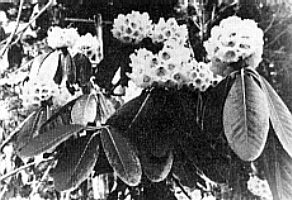
|
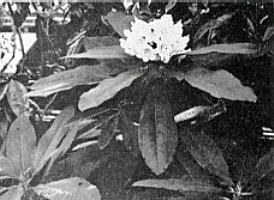
|
|
Fig. 67.
R. falconeri
, taken April 1, 1970
in the garden of Carl H. Phetteplace. Photo by Carl H. Phetteplace, M.D. |
Fig. 68.
R. coriaceum
in flower at the
R. B. G. Edinburgh. Photo by P. H. Brydon |
In the Falconeri series my most frequently acclaimed plant is falconeri itself. It is nearly 14 feet tall at 25 years of age and has flowered unfailingly for the past few seasons. Presently (February 1970) it has pullet-egg sized buds on almost every terminal -perhaps forty. It blooms in late April usually with massive trusses of at least 30 or 40 florets, somewhat flattened, very compact and of a good primrose yellow with a dark blotch (Fig. 67). Flowers have unusual substance generally holding up in fairly good condition for nearly a month. The leaves are approximately a foot long by four inches in width covered below with a felty brown indumentum. There is only one feature that could be faulted: as soon as the new leaves are mature each year all of last year's leaves are rapidly shed leaving only one year's foliage at a time. This gives the plant what might be called a "bony" appearance. However the bark of the trunk and major branches is very handsome as it has a paper-like peeling which leaves a perfectly smooth cinnamon-colored surface.
In contrast, I have grown since 1949 several of the Dr. Joseph Rock numbers from seed which have simply been identified as "Falconeri series." Knowledgeable people trying to identify this group have said that though they were undoubtedly of the Falconeri series they certainly were not falconeri itself. Only one of these plants has flowered-Rock 102. It has a more flattened truss than falconeri with so far somewhat fewer florets but they are of a deep rose color gradually fading to a cream or ivory with age. Most of this group are from five to seven feet tall and are quite similar in appearance. The foliage though large is slightly more oval than falconeri itself and deeper green in color with the same heavy brown felt-like indumentum. However here the foliage persists often three years and sometimes four before falling. The plants therefore are always well clothed and little of the skeleton is seen. It would please me if they could be seen in another 20 years. They must be preserved.
There are two other plants of the Falconeri series in this Rock 1948 collection: R. #120 and R. #140 both coriaceum . The two seem essentially the same except R. #140 often has axillary flower buds and trusses which is unique to me. The foliage is much the same size and shape as falconeri but the indumentum is pure white early and becomes only a slight buff color at maturity. This white new growth standing very erect is beautiful in the early morning sun. These both have many smallish white flowers making up a large rather conical truss. There is a small purple blotch in the floret throat. Both plants should be exhibition specimens ten years from now when trusses should adorn nearly every terminal.
From hand pollinated seed sent to me by my good friend, E. H. M. Cox, I have grown both arizelum and eximium . The former has a particularly attractive rust colored indumentum. Both appear quite typical for their respective species and very interesting but probably will not bloom in the next ten years.
Another likely member of the Falconeri series I have grown for many years came from the Barto collection. The consensus of my visitors is that it is basilicum . It had been badly neglected but the past few years is thriving and is a beautiful plant with long tapered leaves of a dark green color and rich brown indumentum. It is probably over 40 years old. Lately it has bloomed most years. The truss is much like falconeri but a slightly paler yellow.
Fictolacteum is four or five feet tall now as is hodgsonii and rex all of the Falconeri series and good looking plants, but sans flowers to date.
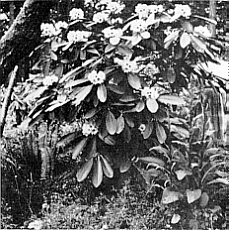
|
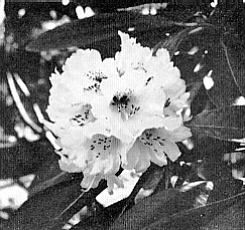
|
|
Fig. 69.
R. rex
in the garden of
Cecil Smith. Photo by Cecil Smith |
Fig. 70.
R. rex,
a close up of a truss.
Photo by Cecil Smith |
In the Grande series there are two plants which came from the same Dr. Rock expedition which are either coryphaeum or praestans . It is said there is no real difference between them except the former has cream colored flowers and the latter pink. One of the plants is six feet tall and has immense leaves with a tight plastered brown indumentum. My grandchildren may live to see it flower.
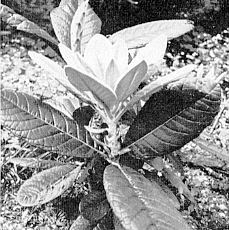
|
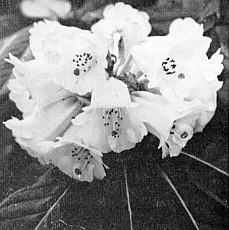
|
|
Fig. 71.
R. macabeanum
,
showing young foliage. Photo by Cecil Smith |
Fig. 72.
R. macabeanum,
a
close up of the truss in Mrs. Rudolph Henny's garden. Photo by Cecil Smith |
About 15 years ago I obtained from Tower Court a small macabeanum T. C. It has done especially well and is a beautiful plant well over seven feet tall. This is said to be a rather tender species but this plant has not had the slightest injury. Its large dark green leaves are covered with white indumentum. I can only imagine how handsome it would be laden with large yellow trusses some fine year. In addition I have three macabeanums from other sources: one K. W. 17407, one from Exbury and one K. W. 7724. These have had a little frost injury at times, but have recovered well, the plants are not nearly so large and of course no flowers. The larger Tower Court should bloom as it is said this species flowers at an earlier age than other large-leafed plants.
There is another 40-year-old Barto plant which had been stunted before I got it, but is now over five feet tall, very handsome and visiting friends seem to think it is semnoides . It, too, has a large many-flowered truss of pale yellow flowers with a blotch. The long leaves have again a rich brown indumentum and are retained at least two years.
Protistum is a very vigorous grower and flowered when ten years old. Although the leaves are large the indumentum is negligible. The truss is slightly loose with 25 or 30 white flowers that have a fragrance that to me seems slightly musty. This plant is over eight feet tall and very worthy.
There is a plant of sidereum K. W. #20838. It is said to be a very good yellow but perhaps one of the most tender of the "big-leafs." It froze to the ground in 1955 but now has many branches four to five feet tall that have come from the base. It has shown no injury since. The foliage is large, rather pointed with a silvery plastered indumentum. I do not expect to see it flower but would not part with it.
A small, small
sinogrande
and
mollyanum
have weathered the past few years with no difficulty. Both have incredibly large leaves but neither have the rich indumentum of some described above.
I wish my father had planted these exceedingly interesting plants on this site when he was a young man. I am sure then all of you who read this now would come at least once to visit me and my garden. Even without flowers they give me much pleasure - and of course always hope.
